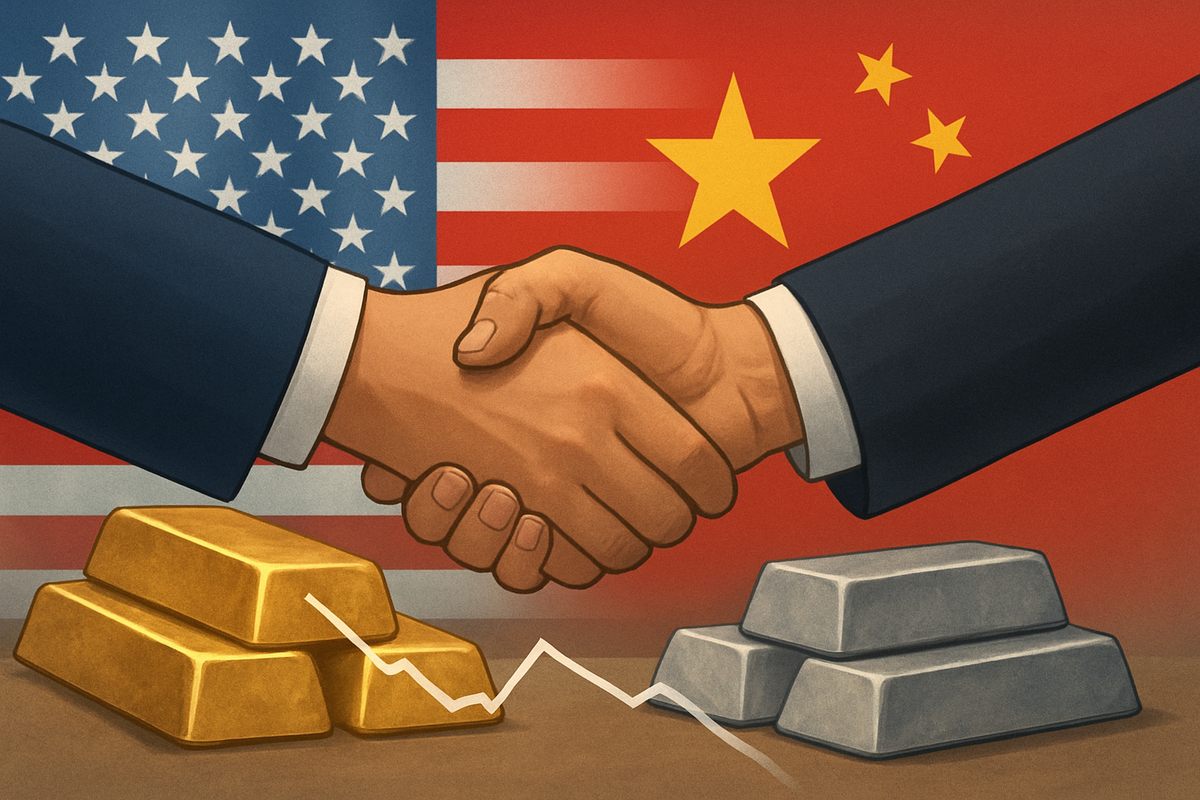
October 27, 2025 - Precious metals markets are experiencing a significant downturn, with gold prices dropping sharply and silver extending its losses, as an imminent trade agreement between the United States and China appears to be on the horizon. The prospect of de-escalating trade tensions has significantly curbed safe-haven demand, a primary driver for bullion's appeal during times of economic and geopolitical uncertainty. Investors are rapidly shifting capital away from traditional hedges and towards riskier assets, signaling a renewed confidence in the global economic outlook.
The positive sentiment surrounding the potential trade breakthrough has sent shockwaves through the commodities market. On Monday, October 27, spot gold saw a notable decline of as much as 1.4%, trading near $4,053 an ounce, adding to a 3.3% loss from the preceding week. Silver mirrored gold's trajectory, with spot prices sliding 1.59% to $47.83 per ounce, following an 11.3% plunge the previous week—its steepest weekly decline since September 2020. This sharp correction marks a significant retreat from recent record highs, with gold having touched $4,380-$4,398 per ounce and silver reaching $53.76 per ounce earlier in October.
Trade Breakthrough Calms Markets, Dents Precious Metals
The catalyst for this market shift is the burgeoning optimism for a comprehensive US-China trade agreement. Officials from both nations have confirmed substantial progress towards a deal, with a "framework" solidified during the Association of Southeast Asian Nations (ASEAN) summit in Malaysia on Sunday, October 26, 2025. This breakthrough sets the stage for a highly anticipated meeting between US President Donald Trump and Chinese President Xi Jinping in South Korea on Thursday, October 30. This summit is expected to finalize the pivotal agreement and avert the imposition of 100% tariffs on Chinese imports, which were slated to begin on November 1.
Key components of the preliminary consensus include China's agreement to delay export controls on rare earth minerals for a year and a commitment to substantially increase purchases of US agricultural products, particularly soybeans. US Treasury Secretary Scott Bessent and China's top trade negotiator, Li Chenggang, have both confirmed these developments, signaling a significant step towards easing a prolonged period of trade friction that has weighed heavily on global markets for years. The timeline of events, from initial discussions to the ASEAN summit and the upcoming presidential meeting, paints a clear picture of a concerted effort to resolve the trade dispute, culminating in the current optimistic outlook.
Initial market reactions have been overwhelmingly positive for equities and negative for safe havens. Asian stock markets surged following the trade deal breakthrough, reflecting a broader improvement in global risk appetite. For precious metals, the impact was immediate and pronounced. COMEX gold (COMEX: GC=F) decreased by $42.90 to $4094.90 per troy ounce, while COMEX silver futures (COMEX: SI=F) for December delivery traded 1.44% lower at $47.88 per ounce. Domestic gold prices in India also reflected this trend, with gold futures on the Multi Commodity Exchange (MCX: GOLD1!) for December delivery declining by Rs 1,546 (1.25%) to Rs 1,21,905 per 10 grams. Beyond the trade deal, a strengthening US dollar, bolstered by renewed trade optimism, has also contributed to the decline by making dollar-denominated gold more expensive for international buyers. Investors have also engaged in significant profit-taking after the strong rallies observed in both gold and silver over the preceding months.
Mining Companies and ETFs Face Headwinds Amid Reduced Safe-Haven Demand
The sharp decline in gold and silver prices, driven by diminishing safe-haven demand, is poised to create both winners and losers within the financial markets. Companies heavily invested in or reliant on high precious metal prices are likely to face significant headwinds, while sectors that benefit from increased risk appetite could see a boost.
Mining companies, particularly those focused on gold and silver extraction, are among the most exposed to these price fluctuations. Major gold producers like Barrick Gold Corporation (NYSE: GOLD) and Newmont Corporation (NYSE: NEM) could see their revenues and profit margins squeezed if lower prices persist. Their operational costs remain relatively stable, but the value of their output decreases, directly impacting their bottom line. Similarly, silver miners such as Pan American Silver Corp. (NASDAQ: PAAS) and Wheaton Precious Metals Corp. (NYSE: WPM) will feel the pressure, especially given silver's more pronounced volatility and its dual role as an industrial and precious metal. Exploration and development budgets might be curtailed, and less profitable mines could face closure or reduced output, potentially affecting employment in the sector.
Conversely, exchange-traded funds (ETFs) that track gold and silver prices, such as the SPDR Gold Shares (NYSEARCA: GLD) and iShares Silver Trust (NYSEARCA: SLV), are experiencing outflows as investors liquidate their positions. These funds, which saw substantial inflows during periods of high uncertainty, are now witnessing a reversal as capital seeks higher returns in other asset classes. While a prolonged downturn could hurt the asset under management for these ETFs, it also presents a potential buying opportunity for contrarian investors who believe in a future rebound. Investors holding individual mining stocks or precious metal ETFs will need to closely monitor their portfolios for further volatility and consider their long-term investment strategies.
On the other hand, companies and sectors that thrive in an environment of reduced global risk and increased economic confidence stand to benefit. Technology companies, consumer discretionary firms, and industrial sectors, which often underperform during periods of uncertainty, could see renewed investor interest. Financial institutions that facilitate international trade and investment may also experience increased activity. The improved trade outlook could also lead to a stronger US dollar, which, while negative for gold, benefits US-based companies with significant international revenues when repatriating profits. This reallocation of capital signifies a broader market shift from defensive plays to growth-oriented investments, reflecting the market's positive interpretation of the US-China trade de-escalation.
Broader Significance: A Shift in Global Economic Sentiment
The impending US-China trade deal and its subsequent impact on precious metals prices signify a broader shift in global economic sentiment, moving away from a period dominated by trade protectionism and geopolitical friction towards renewed optimism and stability. This event is not merely a transient market reaction but a potential inflection point that could reshape investment strategies and international relations.
Historically, gold and silver have served as reliable barometers of global anxiety. Their recent rally to multi-year highs was a direct consequence of the protracted US-China trade war, Brexit uncertainties, and other geopolitical flashpoints. The current downturn, therefore, underscores a collective sigh of relief from market participants. This de-escalation fits into a broader trend of central banks globally reassessing monetary policies, with the Federal Reserve expected to announce a 25 basis point rate cut, further influencing currency strength and investor appetite for yield-bearing assets over non-yielding precious metals. While other geopolitical risks, such as the Israel-Hamas conflict and the war in Ukraine, persist, the overwhelming impact of the US-China trade deal on systemic economic risk has overshadowed these regional concerns in the precious metals market.
The ripple effects of a trade agreement are extensive. For competitors and partners of the US and China, the reduction in trade barriers could stabilize supply chains, lower input costs, and foster greater predictability in international commerce. Industries heavily reliant on cross-border trade, from manufacturing to logistics, stand to benefit. Regulatory implications include a potential easing of trade-related tariffs and non-tariff barriers, which could spur investment and economic growth. However, there might also be increased scrutiny on intellectual property rights and market access, as part of the broader agreement's enforcement mechanisms. Comparing this to historical precedents, such as the resolution of past trade disputes or the end of significant geopolitical tensions, often shows a similar pattern: an initial flight from safe havens, followed by a sustained period of growth in risk assets, provided the underlying economic fundamentals remain sound. This event reinforces the idea that global economic stability, rather than regional conflicts, remains the primary driver for broad market movements in precious metals.
What Comes Next: A New Era for Precious Metals and Global Trade
The immediate aftermath of an imminent US-China trade deal suggests a continued recalibration of market expectations, particularly for precious metals. In the short term, gold and silver prices are likely to remain under pressure as investors fully price in the reduced safe-haven demand and potentially further strengthen the US dollar. We could see continued profit-taking, especially if the formal signing of the deal on October 30, 2025, goes smoothly and is met with further positive market sentiment. This might lead to a period of consolidation for bullion, potentially establishing new, lower price floors compared to their recent highs.
Looking further ahead, the long-term possibilities for precious metals will hinge on several factors beyond just trade relations. While the immediate threat of a US-China trade war may recede, other geopolitical flashpoints, such as ongoing conflicts in the Middle East and Eastern Europe, could reignite safe-haven demand. Additionally, the trajectory of global economic growth, inflation expectations, and central bank monetary policies will play a crucial role. If global economic growth accelerates significantly, leading to higher interest rates and a stronger dollar, gold and silver could face sustained headwinds. Conversely, any unexpected economic slowdown or renewed geopolitical instability could provide a floor for prices and potentially trigger a rebound.
Market opportunities may emerge for investors looking to buy gold and silver at potentially lower valuations, especially if they believe the long-term fundamentals for precious metals as a store of value remain intact. Strategic pivots for mining companies might include focusing on cost efficiency, exploring new extraction technologies, or diversifying their operations to include other industrial metals. For investors, this period calls for a reassessment of portfolio allocations, potentially shifting from an overweight position in safe havens to a more balanced approach that includes growth-oriented assets. Potential scenarios range from a sustained period of lower precious metal prices if global stability holds, to a gradual recovery if other uncertainties emerge. The key will be to monitor not just trade developments, but also broader macroeconomic indicators and geopolitical shifts.
Market Reassessment and Future Outlook for Investors
The recent sharp decline in gold and silver prices, triggered by the imminent US-China trade deal, serves as a powerful reminder of the profound influence of geopolitical stability on financial markets. The key takeaway from this event is the significant unwinding of safe-haven demand that had propelled precious metals to multi-year highs. As global risk appetite improves, capital is flowing out of defensive assets and into more growth-oriented investments, signaling a broader market reassessment of risk and opportunity.
Moving forward, the market will likely consolidate the gains made in risk assets and the losses incurred in safe havens. While the immediate impact of the US-China trade deal is clear, investors should remain vigilant for other factors that could influence precious metal prices. These include the actual implementation and adherence to the trade agreement, the evolving landscape of other geopolitical tensions, global inflation trends, and the monetary policy decisions of major central banks, particularly the Federal Reserve. A strengthening US dollar, often a consequence of reduced global uncertainty and a robust US economy, will continue to exert downward pressure on dollar-denominated gold and silver.
In conclusion, the current market dynamic represents a pivotal moment, potentially ushering in a new era of global trade relations and investment strategies. While the allure of precious metals as a safe haven has diminished in the short term, their fundamental role as a hedge against extreme uncertainty or currency debasement remains relevant in the long run. Investors should carefully assess their risk tolerance and investment objectives, considering a diversified portfolio that accounts for both the potential for continued global stability and the ever-present possibility of unforeseen events. Watching for consistent signs of economic growth, the stability of international trade relations, and any shifts in central bank rhetoric will be crucial in the coming months to navigate the evolving landscape of the precious metals market.
This content is intended for informational purposes only and is not financial advice






